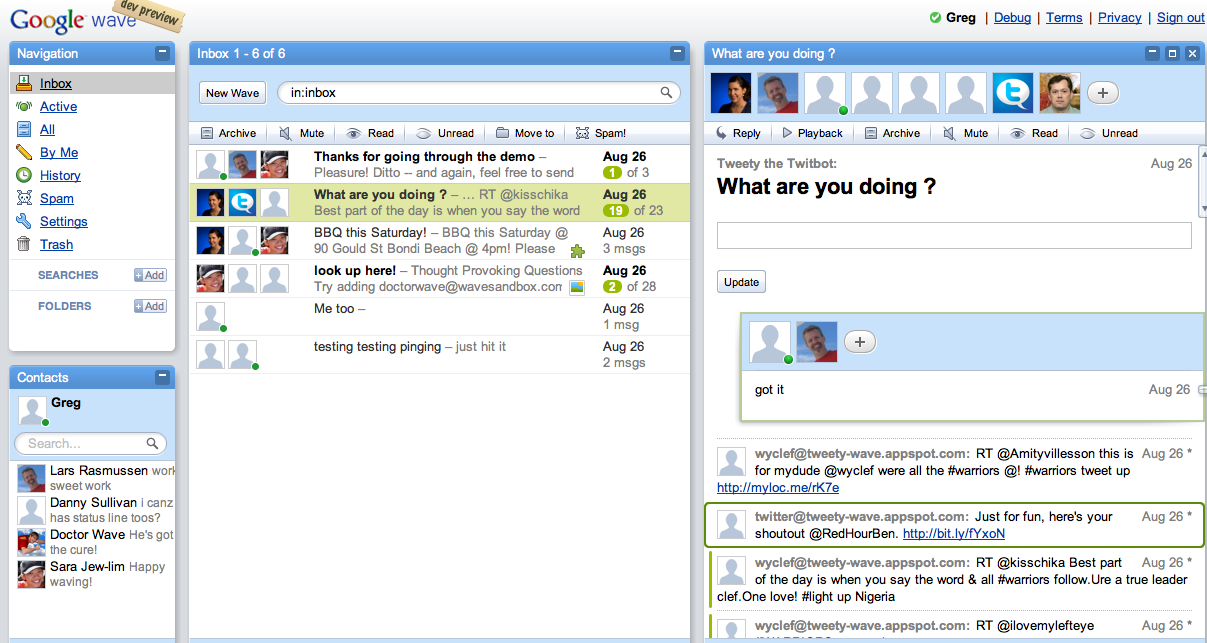Google Expanding Access To Wave Soon, First “Hands-On” Impressions
At the end of next month, September 30, Google will expand the current “developer preview” of Google Wave to roughly 100,000 consumer users. According to Google, “included in this group of early testers will be some of the businesses using Google Apps.” In anticipation of this wider release, Danny and I got some time with Lars Rasmussen […]
At the end of next month, September 30, Google will expand the current “developer preview” of Google Wave to roughly 100,000 consumer users. According to Google, “included in this group of early testers will be some of the businesses using Google Apps.” In anticipation of this wider release, Danny and I got some time with Lars Rasmussen and the rest of the Google Wave team the other day.
By way of background, Danny and I wrote about Wave when it was first announced earlier this year and then offered some third-party developer observations.

Without doing a full “review,” I’ll offer some initial thoughts from my 50 or so minutes with the Wave team and hands-on experience with Wave:
It’s an exciting — possibly breakthrough — product that eludes simple categorization. Wave does lots of things and has the potential to do many more. However, there’s almost a “cultural” adaptation necessitated by it. People have to get used to communicating in a kind of “layered” way that Wave both allows and almost requires.
The screenshot above, from our Wave demo, looks a lot like an email client. But Wave permits multiple people to interact in real-time with each other. It’s a mix of email and IM with some Twitter and iGoogle thrown in. Speaking of the latter, Wave will spawn a developer ecosystem and permits existing Google Gadgets and the new social gadgets to work within it. In other words, developers can build apps and users can access or import them within the platform and individual waves (conversations).
There’s also drag and drop photo sharing. One cool related feature allows full-screen slideshows of images added by any user participating in a wave. (Yahoo has been taking incremental steps toward something more like this with its series of Yahoo Mail upgrades.)
Wave can also act as a Twitter client or embed Twitter clients (and one would assume eventually Facebook too). One could also imagine it as a feed reader for news. Indeed, third party developer efforts will enable Wave to grow and change, built around basic functionality of real-time communication and collaboration. One could easily imagine Google Voice and Google Talk integration into Wave, and so on.
It may be premature to discuss this, but a key to the mainstream appeal and adoption of Wave will be its ability to incorporate existing email accounts and to function as a client for traditional email.
During the demo most of the emphasis had been on enterprise or B2B collaboration. It struck me that teens would recognize this as a social tool and potential successor to IM — and would take to it accordingly. I made a comment along those lines and Google’s Rasmussen conveyed an anecdote about a test with Sydney (Australia) 3rd graders who used Wave and apparently had a great deal of fun with it.
That’s saying something if both developers and 3rd graders can equally use it. However, as Wave rolls out and more people are exposed, more of its potential and an expanding list of scenarios and use cases will likely emerge.
Contributing authors are invited to create content for Search Engine Land and are chosen for their expertise and contribution to the search community. Our contributors work under the oversight of the editorial staff and contributions are checked for quality and relevance to our readers. The opinions they express are their own.
Related stories
New on Search Engine Land